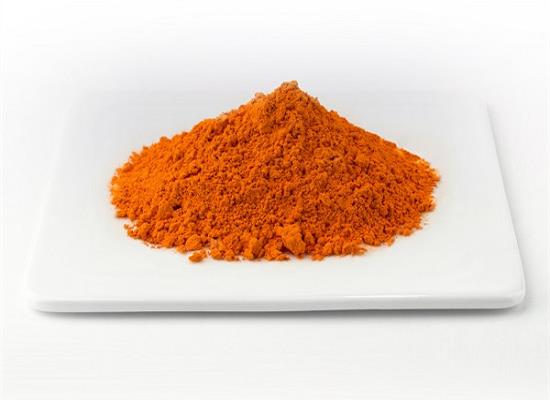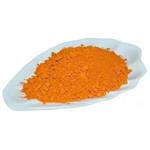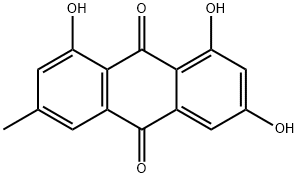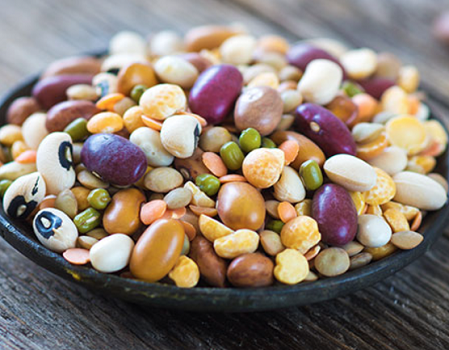Emodin: Pharmacological Activities and Toxicity
General Description
Emodin is a natural anthraquinone derivative that occurs in many widely used Chinese medicinal herbs, such as Rheum palmatum, Polygonum cuspidatum and Polygonum multiflorum. Emodin has been used as a traditional Chinese medicine for over 2000 years and is still present in various herbal preparations. Emerging evidence indicates that emodin possesses a wide spectrum of pharmacological properties, including anticancer, hepatoprotective, antiinflammatory, antioxidant and antimicrobial activities. Besides, researchers also found there remains some side effect.

Figure 1. Emodin
Pharmacological Activities
Anti-cancer activity
A large body of evidence is available that confirms the ability of Emodin to prevent and/or curb the development of tumours. It was reported that the compound exerted cytotoxic effects against a variety of cancer cell lines and inhibited the proliferation of human cervical (HeLa), kidney (Vero), hematopoietic (Raji), gastric (SGC7901), amniotic (Wish), ovarian (SK-OV-3), melanoma (SK-MEL-2), liver (HepG2), CNS (XF498), colon (HCT-8, HCT15), lung (A549, Calu-1), and breast (MDA-MB-231) cancer cell lines. In addition, it also showed remarkable in vivo anti-tumour activity in various animal models.1
Anti-inflammatory activity
The strong anti-inflammatory properties of Emodin at 74 μM was demonstrated in RAW 264.7 macrophages against LPS-induced inflammatory responses by inhibiting the expression of a panel of inflammatory-associated genes, including TNF-α, iNOS and IL-10. It attenuated the release of TNF-α and IL-10 in response to LPS in normal peripheral blood mononucleated cells (PBMC), while stimulating septic PBMC in severe sepsis patients. Wang et al. (2002) reported the effect of Emodin on the inhibition of NO production from RAW 264.7 cells. They found that it inhibited NO2 production from LPS-activated RAW 264.7 cells with an IC50 of 60.7 μM. It also reduced paw swelling induced by carrageenan in mice and rat models, by reducing the oedema volume by up to 68% at a dose of 40 mg/kg, while elevating the accumulation of R-123 in Caco-2 cells.
An intra-peritoneal administration of Emodin resulted in anti-inflammatory activity against carrageenan-induced paw inflammation in rats at a dose of 15 mg/kg. Furthermore, EM displayed COX-2 inhibitory activity and was able to modulate P-gp function and expression. The compound suppressed TNF-α-induced fibroblast migration and fibronectin deposition in vitro and inhibited TNF-α-induced NF-κB p65 and c-Jun N-terminal kinase activation. Han et al. (2015) suggested that EM attenuates IL-1β secretion via the inhibition of NLRP3 inflammasome activation, induced by ATP, nigericin, and silica crystals. In addition, Emodin ameliorated the severity of NLRP3 inflammasome-mediated symptoms in LPS-induced endotoxin mice.1
Toxicity
The US National Toxicology Program showed that emodin exposure resulted in increased incidences of renal tubule pigmentation in male and female mice and increased incidences of nephropathy in female mice. The administration of emodin (40 and 80 μM) for 24 h resulted in a significant decrease in cell viability by approximately 29% and 45%, respectively, which was mediated through the induction of apoptosis in the caspase 3-dependent pathway and the mitochondrial pathway. Another study demonstrated that emodin also significantly inhibited the proliferation of HK-2 cells, with IC 50 values of 130.65 μM.2
Emodin has been reported to exert reproductive toxicity. In male reproductive organs/tissues, the toxicity study of emodin indicated that it has testicular toxicity because of the disruption of the expression of testicular genes. Luo et al. demonstrated that emodin also inhibited human sperm functions by reducing sperm [Ca 2+ ]i and suppressing tyrosine phosphorylation in vitro. Ethanol solution extracts of R. patientia, which contain anthraquinones, such as emodin and chrysophanol, as active ingredients, caused irreversible pathological changes at very high doses (4000 mg/kg), although lower doses and aqueous extracts produced either non-significant or reversible changes. Therefore, long-term administration of high doses of anthraquinones extracts should be avoided altogether during pregnancy.2
References:
[1] RUCHI BADONI SEMWAL . Emodin - A natural anthraquinone derivative with diverse pharmacological activities[J]. Phytochemistry, 2021, 190. DOI:10.1016/j.phytochem.2021.112854.[2] XIAOXV DONG. Emodin: A Review of its Pharmacology, Toxicity and Pharmacokinetics.[J]. Phytotherapy Research, 2016, 30 8. DOI:10.1002/ptr.5631.
You may like
Lastest Price from Emodin manufacturers

US $1200.00-1100.00/ton2025-10-17
- CAS:
- 518-82-1
- Min. Order:
- 1ton
- Purity:
- 99%
- Supply Ability:
- 1000T/M

US $0.00/kg2025-04-24
- CAS:
- 518-82-1
- Min. Order:
- 1kg
- Purity:
- 0.99
- Supply Ability:
- 1000kg


